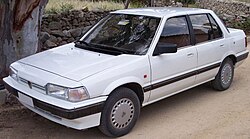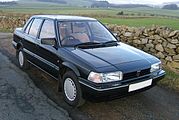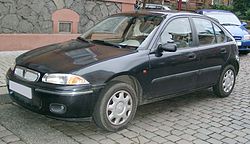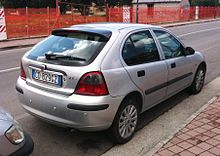Rover 200 series
| Rover 200 | |
|---|---|
| Production period: | 1984-2005 |
| Class : | Compact class |
| Body versions : | Sedan , station wagon , coupé , convertible |
| Previous model: | Austin Maestro |
| Successor: | MG / Roewe 350 |
Rover 200 series is the collective name for three vehicle models that were produced by the former British car manufacturer Rover between autumn 1984 and mid-2005 . The vehicles manufactured until summer 1995 belonged to the compact class , later automobiles were assigned to the small cars . The last time the manufacturer used the name Rover 25.
200 (Type XH, 1984–1989)
| 1st generation | |
|---|---|
|
Rover 213 SE (1984–1987) |
|
| Production period: | 1984-1989 |
| Body versions : | limousine |
| Engines: |
Petrol engines : 1.3-1.6 liters (52-77 kW) |
| Length: | 4156 mm |
| Width: | 1623 mm |
| Height: | 1378 mm |
| Wheelbase : | 2450 mm |
| Empty weight : | |
The 200 series was born in 1984. The first series was created under the development code XH or SD3.
This car was originally developed by Honda as the Honda Civic Notchback. This vehicle was intended to replace the previously successfully built Triumph Acclaim (or Honda Ballade) series, which had sold around 280,000 times as Triumph from autumn 1981 to summer 1984. This model and the planning for its successor, the first Rover model 200 , were still under the great umbrella organization British Leyland , under which - with the exception of Rolls-Royce and Bentley, Aston Martin and a few others - almost the entire automotive world in Great Britain is assembled had been planned and developed.
Since British Leyland had become weaker and less competitive over time, a cooperation agreement had been concluded with Honda in 1978, which was later expanded with a 20 percent cross-shareholding in the joint venture. With this, Honda made it possible for the British operating in the automotive upper house to open up further market segments below the classic rover segment, which until then had been more poorly covered by Austin and Morris under British Leyland .
Until now, the range had only included the large Rover SD1 , which represented the market for luxury and business cars with various engines from two liters upwards, but the Rover 200, which debuted as the 213 and 216, added further customer potential. This was made possible by the fact that Triumph was withdrawn from the market without replacement. The new vehicle was an approx. 4.2 meter long sedan with four doors in a classic notchback design. The engine could be taken from the type designation, which, just like with BMW, first names the series and then the engine. A Rover 216 was therefore a model of the 200 series with 1.6 liter displacement. The cars were sold as the 213 with a 1.3 liter Honda 71 hp engine and electronic carburetor. The 1.6-liter engine had 63 kW (85 hp) with an electronic carburetor and 77 kW (105 hp) with manifold injection . The 1.6 liter machines were English S series engines.
The British had a little more influence on the interior than on the previous model. The nose and tail also differed more than the Acclaim from its Honda sister model. The top versions were called Vitesse, based on the large eight-cylinder Rover or Vanden Plas , which were not available in Germany. The sporty version (Vitesse) and the luxury version (Vanden Plas) with wood and leather quickly earned the car the respect of customers and a reputation as a more worthy English opponent of the BMW 3- series.
The replacement of the large Rover SD1 with the introduction of the Rover 800 in autumn 1986 brought the 200 series a small facelift in spring 1987 with borrowings from the new Rover 800 .
After sales rose annually, the model series was replaced by the second 200 series based on the Honda Concerto in autumn 1989 (at the height of its construction period) .
The successor to the Triumph Acclaim had successfully sold around 300,000 times, paving the way for Rover into a new segment. His successor was to surpass this success many times over.
Technical specifications
| 213 213 S 213 SE |
216 S 216 SE |
216 Vanden Plas EFi 216 Vitesse |
|
|---|---|---|---|
| Engine characteristics | |||
| Engine type | R4 petrol engine | ||
| Number of valves per cylinder | 3 | 2 | |
| Valve control | OHC, timing belt | ||
| Mixture preparation | Carburetor | Manifold injection | |
| Engine charging | - | ||
| cooling | Water cooling | ||
| Bore × stroke | 74.0 mm × 78.0 mm | 76.2 mm x 87.3 mm | |
| Displacement | 1342 cc | 1598 cc | |
| Compression ratio | 8.7: 1 | 9.3: 1 | |
| Max. Power at min −1 | 52 kW (71 PS) / 6000 |
63 kW (85 PS) / 5600 |
77 kW (105 PS) / 6000 |
| Max. Torque in min -1 | 102 Nm / 3500 |
131 Nm / 3500 |
138 Nm / 3500 |
| Power transmission | |||
| drive | Front wheel drive | ||
| Gearbox, as standard | 5-speed manual transmission | ||
| Gearbox, optional | 3-speed automatic transmission |
- | 4-stage automatic transmission |
| Readings | |||
| Top speed | 154 km / h | 164 km / h | 174-180 km / h |
| Acceleration, 0-100 km / h | 11.7 s | 10.1 s | 9.2-9.4 s |
| Fuel consumption over 100 km (combined) | 6.7 l N. | 6.9 l p | 6.7-7.1 s |
200 (Type XW, 1989–1995)
| 2nd generation | |
|---|---|
|
Rover 214 five-door (1989–1995) |
|
| Production period: | 1989-1995 |
| Body versions : | Station wagon , coupe , convertible |
| Engines: |
Otto engines : 1.4–2.0 liters (55–147 kW) Diesel engines : 1.8–1.9 liters (52–66 kW) |
| Length: | 4220-4370 mm |
| Width: | 1680 mm |
| Height: | 1370-1400 mm |
| Wheelbase : | 2550 mm |
| Empty weight : | |
The Rover 200 (and also 400) of the XW type was built from autumn 1989 to summer 1995 as a three- or five-door hatchback sedan, coupé and convertible.
The difference between the 400 and 200 models is in the body. The Rover 400 is a notchback sedan which was developed by Rover from the 200 and to which Honda had no direct counterpart. The notchback Civic was a completely different vehicle.
The engines came from Honda at the beginning of production and made 66/82 kW (with single camshaft ) and 90 kW (with two camshafts ) in the Rover 216 GSI / GTi.
This 200 series was largely identical to the five-door Honda Concerto . The Concerto for the European markets was built on the same belt at the Austin Rover Longbridge plant in Birmingham . In contrast to Honda, Rover developed an entire model family from the basic model (similar to Opel, for example with the Astra). The Rover exclusive models were three-door as the Rover 216 GTI or 220 GSI.
For the convertible models 214 and 216, which appeared at the end of 1991 and were built in parallel to the successor RF until the end of 1999 (with its new dashboard and the K-series engines), there was also no comparable counterpart Honda. The 216 had an electric top and could be ordered with leather. There were also special models that were equipped with leather.
Also unique was the Rover 200 Coupé presented in the summer of 1992, a sports car that competed against Vauxhall and Opel Calibra , Alfa Romeo GTV , VW Corrado and Fiat Coupé . The versions were called 216 and 220, the latter also being available as a turbo version. The special thing about the car was the so-called "Targa roof", a split glass roof that could be removed in half or completely.
Picture gallery
Rover 400
Another Rover development was the four-door sedan, which was marketed as the Rover 400 , establishing its own series and was supposed to act as the actual successor to the first Rover 200 notchback.
The last special feature was the 400 Tourer , a station wagon developed from the modular system - on the stretched 400 limousine floor assembly - which was planned more as a classy van than really as a load station wagon. In comparison with the 3 Series Touring from BMW at the time, the similarities are striking, although the components did not match. Since the Rover Tourer was considerably cheaper than the BMW model, BMW, as the new Rover owner (1994–2000), soon phased out production of the Tourer after taking over.
Engines
When it comes to engines, there was a wide range of petrol from Honda and Rover. The versions in Germany included 1.4, 1.6, 2.0 liter machines. The 1.1 liter gasoline engine for southern Europe and the 1.9 liter naturally aspirated diesel engine and 1.8 liter turbo diesel engine from Peugeot were not available for German markets .
Initially, Honda units were installed, which under BMW (1994-2000) were exchanged for K-series and T-series engines from Rover. The power spectrum ranged from 44 kW in the 1.1 liter engine (K series) to 147 kW (turbo engine of the T series), the same engine that was also installed in the Rover 620 Ti and Rover 820 Turbo.
In Great Britain, the turbo was also installed in the 400 notchback sedan. The cars were also in competition with the BMW 3-series on the English home market, especially in the turbo versions. During its six-year production period, the entire XW model range produced one million units. It was thus by far the most successful Rover series of all time and held the production record with 20% of all cars ever built under the Rover name between 1904 and the end of the brand in summer 2005.
200 (type RF, 1995–1999)
| 3rd generation | |
|---|---|
|
Rover 214 Si |
|
| Production period: | 1995-1999 |
| Body versions : | Station wagon |
| Engines: |
Otto engines : 1.4–1.8 liters (55–107 kW) Diesel engines : 2.0 liters (63–77 kW) |
| Length: | 3970 mm |
| Width: | 1690 mm |
| Height: | 1420 mm |
| Wheelbase : | 2500 mm |
| Empty weight : | |
The third generation of the 200 series (type RF) was produced from autumn 1995 to the end of 1999. Although similarities with Honda models appeared obvious, the RF series was a proprietary design by Rover. However, some components such as B. the front brake system is actually installed in the Honda Civic.
The RF also replaced the Austin Maestro . Due to its smaller external dimensions, it belonged to the small car class, since the Rover 400, which was renewed in mid-1995, now occupied the compact class alone.
The engine list included gasoline engines with displacement sizes of 1.4 l (55 kW and 76 kW), 1.6 l (83 kW), 1.8 l as 16-valve engines with or without VVC (with 88 kW or 108 kW ), as well as a 2.0-liter turbo diesel engine - from 1998 also with a charge air cooler and 77 kW. In other European countries, a smaller gasoline engine with 1.1 l displacement and 44 kW was also offered.
Model names from 1995 to 1998 (in Germany):
Otto:
- 214 i - 1.4 l 8V with 55 kW / 75 PS
- 214 Si - 1.4 l 16V with 76 kW / 103 PS
- 216 Si - 1.6 l 16V with 82 kW / 112 PS
- 218 Si - 1.8 l 16V with 88 kW / 120 PS
- 218 Si - 1.8 l 16V VVC with 107 kW / 145 PS
- 200 Vi - 1.8 l 16V VVC with 107 kW / 145 PS
Diesel:
- 220 D - 2.0 l with 63 kW / 86 PS
- 220 SD - 2.0 l with 63 kW / 86 PS
- 220 SDi - 2.0 l with 77 kW / 105 PS
Production changes: 1995 - Start of production of the Rover 200 (type RF).
1997 - ABS and ZV with remote control as standard on all models. Starting this year, the central locking acknowledgment was also installed via the hazard warning lights.
1998 - Model name "Rover 200" standardized for all models.
1999 - Disc brakes were now installed as standard on the rear axle instead of the drum brake system.
25 (type RF, 1999-2005)
| 3rd generation (facelift) | |
|---|---|
|
Rover 25 (1999-2004) |
|
| Production period: | 1999-2005 |
| Body versions : | Station wagon |
| Engines: |
Petrol engines : 1.4–1.8 liters (62–118 kW) Diesel engines : 2.0 liters (74–83 kW) |
| Length: | 3990 mm |
| Width: | 1690 mm |
| Height: | 1420 mm |
| Wheelbase : | 2500 mm |
| Empty weight : | |
A revised version called the Rover 25 was presented in late 1999. This version had a front based on the larger Rover 75 .
| Stars in the Euro NCAP - Crash Test (2001) |
|
The chassis has been upgraded to allow sportier handling, with the settings carried over from the 200 Vi. The front had been redesigned to make the family resemblance to other models (such as the Rover 75) more obvious, but the relationship with the 200 series was clearly recognizable. The petrol engines have been slightly revised. The small 1.4-liter 8V engine with 55 kW was replaced by a 1.4-liter 16V engine with 62 kW. The same 1.4-liter engine with a larger throttle valve delivers 76 kW in the Rover 25. The 1.6-liter engine, previously with 82 kW, has been replaced by an 80-kW variant. The 2.0-liter diesel engine from the predecessor was now offered with 74 kW (in other European countries also with 83 kW).
From the end of 2000 there was also an economical 1.1-liter 16V engine with 55 kW in the Rover 25, which had above-average torque development compared to similar 1.2 and 1.3-liter machines.
The model designations for the 25 did not follow the engine as in the 200 series. In Germany, the models were differentiated according to the equipment lines Basic, Classic, Charme, Celeste, Sport and Sport Plus.
Engine overview
Gasoline engine:
- 1.1 liter, 16V, in-line four-cylinder with 1119 cm³ displacement with 55 kW (75 PS), 2000–2005
- 1.4 liter, 16V, in-line four-cylinder with 1396 cm³ displacement with 62 kW (84 hp), 1999–2005
- 1.4 liter, 16V, in-line four-cylinder with 1396 cm³ displacement with 76 kW (103 PS), 1999–2005
- 1.6 liter, 16V, in-line four-cylinder with 1588 cm³ displacement with 80 kW (109 PS), 1999–2005
- 1.8 liter, 16V, in-line four-cylinder with 1796 cm³ displacement with 86 kW (117 hp), 1999–2001
- 1.8 liter, 16V, in-line four-cylinder with 1796 cm³ displacement with 107 kW (145 PS), 1999–2001
- 1.8 liter, 16V (MG ZR), in-line four-cylinder with 1796 cm³ displacement with 118 kW (160 PS), 2001-2005
Diesel:
- 2.0 liter, 8V, in-line four-cylinder with 1994 cm³ displacement with 74 kW (101 PS), 2000-2005
- 2.0 liter, 8V, in-line four-cylinder with 1994 cm³ displacement with 83 kW (113 hp), 2003-2005
A commercial about the Rover 25, which shows a spinning roulette wheel, was set to music by “Mono” (Life in Mono).
Less than a year after the Rover 25 came out, BMW sold the Rover division to the Phoenix Consortium for the symbolic sum of £ 10. In summer 2001 the newly formed MG Rover Group introduced a sporty version of the Rover 25 - the MG ZR 160. The interior and exterior styling had been revised, and it now had a sportier chassis.
The most powerful engine on offer was the 1.8-liter VVC engine with 118 kW (160 PS), which gave the car a top speed of 210 km / h. A year later, the ZR was also available as a 1.4 l with 76 kW (103 PS).
Facelift
At the beginning of 2004 the models 25 and MG ZR were revised outside and inside so that they now looked more modern and of higher quality. Most of the changes, however, were in the interior: a completely new design in the interior and instrumentation.
Production of both vehicles was stopped in May 2005 when the company had to register a comparison.
The plans for the Rover 25 were bought by the Shanghai Automotive Industry Corporation (SAIC) in spring 2005, while the new owner Nanjing owns the tools for the model. The two state-owned companies SAIC and Nanjing have now been merged. In the People's Republic of China, the Rover 25 was named Roewe 250 in the hatchback version and Roewe 350 as a notchback version. The model was built there for the local market under these market names until 2008.
Complete overview of engines
Otto engines:
- 211: 1.1-liter four-cylinder 8V with 44 kW / 60 PS (not in Germany)
- 213 S: 1.3-liter four-cylinder 12V with 52 kW / 71 PS
- 214 i: 1.4-liter four-cylinder 8V with 55 kW / 75 PS
- 214 Si: 1.4-liter four-cylinder 16V with 76 kW / 103 PS
- 216 S: 1.6-liter four-cylinder 8V with 63 kW / 85 PS
- 216 Vitesse: 1.6-liter four-cylinder 8V with 77 kW / 105 PS
- 216 Si: 1.6-liter four-cylinder 16V with 82 kW / 112 hp
- 216 GSi: 1.6-liter four-cylinder 16V with 82 kW / 112 hp
- 216 GTi: 1.6-liter four-cylinder 16V with 90 kW / 122 PS
- 218 Si: 1.8-liter four-cylinder 16V with 88 kW / 120 PS
- 218 Si: 1.8-liter VVC four-cylinder 16V with 107 kW / 145 PS
- 200 Vi: 1.8-liter VVC four-cylinder 16V with 107 kW / 145 PS
- 220 GSi: 2.0-liter four-cylinder 16V with 100 kW / 136 PS
- 220 Turbo: 2.0-liter four-cylinder 16V with 147 kW / 200 PS
- 25: 1.1-liter four-cylinder 16V with 55 kW / 75 PS (not in Germany)
- 25: 1.4-liter four-cylinder 16V with 62 kW / 84 PS
- 25: 1.4-liter four-cylinder 16V with 76 kW / 103 PS
- 25: 1.6-liter four-cylinder 16V with 80 kW / 109 PS
- 25: 1.8-liter four-cylinder 16V with 86 kW / 117 hp
- 25: 1.8-liter four-cylinder 16V with VVC 107 kW / 145 PS
- MG ZR 105: 1.4-liter four-cylinder 16V with 76 kW / 103 PS
- MG ZR 120: 1.8-liter four-cylinder 16V with 86 kW / 117 PS (not in Germany)
- MG ZR 160: 1.8-liter VVC four-cylinder 16V with 118 kW / 160 PS
Diesel:
- 218 D: 1.8-liter four-cylinder 8V with 65 kW / 88 PS (from Peugeot)
- 220 D: 2.0-liter four-cylinder 8V with 63 kW / 86 PS
- 220 SD: 2.0-liter four-cylinder 8V with 63 kW / 86 PS
- 220 SDi: 2.0-liter four-cylinder 8V with 77 kW / 105 PS
- 25 IDT: 2.0-liter four-cylinder 8V with 74 kW / 101 hp
- 25 IDT: 2.0-liter four-cylinder 8V with 83 kW / 113 PS (not in Germany)
- MG ZR 101: 2.0-liter four-cylinder 8V with 74 kW / 101 PS
- MG ZR 115: 2.0-liter four-cylinder 8V with 83 kW / 113 PS (not in Germany)
literature
- Auto catalog 1986/87
Web links
Individual evidence
- ^ Results of the Rover 25 in the Euro NCAP crash test
- ↑ Cars without a successor (Fig. 40) on Autobild.de (accessed on August 4, 2010)














